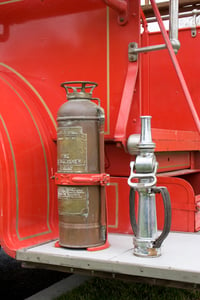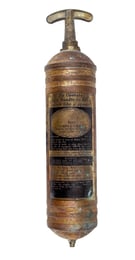
Today, fire extinguishers are considered a no-brainer when it comes to fire and life safety. Generally, most people know what they look like, as well as how – and when – to use them.
But, how were fire extinguishers invented in the first place?
In this blog, we’re exploring the history behind fire extinguishers and taking a look at how this essential piece of fire safety equipment came to be.
Early fire extinguishers
The first ever fire extinguisher on record was patented in England in 1723, and it was created by Ambrose Godfrey, who was a well-known and celebrated chemist at that time. This extinguisher had a cask of fire-extinguishing liquid, as well as a chamber containing gun powder. The device was connected through a series of fuses that would be set off, causing the gun powder to explode and the liquid to scatter, putting out the fire. There’s evidence it was used in stopping a fire in London in 1729.
Another extinguisher was created in the early 1800s by British Captain George William Manby. It contained 3 gallons of pearl ash solution, along with compressed air. When operated, it would shoot the liquid onto the fire, helping to put it out.
Soda-acid extinguishers gained traction next, with patents in France in 1866, and in the U.S. in 1880. Both essentially combined sodium bicarbonate, or baking soda, with an acid to produce C02 gas and pressurized water that would expel from the device.
Over time, various other extinguishers came and went, including ones using carbon tetrachloride, ones using sodium and aluminum, and other versions.
But it wasn’t until the early 1900s that we’d see a closer iteration of the fire extinguishers we know today here in the United States.
The first "modern" extinguisher
 Today, many common fire extinguishers use carbon dioxide. The first extinguisher of this kind in the U.S. was invented by the Walter Kiddie Company in 1924. It was created to respond to a need for an extinguisher that used chemicals that were electrically non-conductive, to put out fires in telephone switchboards – a common occurrence at this point in time.
Today, many common fire extinguishers use carbon dioxide. The first extinguisher of this kind in the U.S. was invented by the Walter Kiddie Company in 1924. It was created to respond to a need for an extinguisher that used chemicals that were electrically non-conductive, to put out fires in telephone switchboards – a common occurrence at this point in time.
This extinguisher had a tall, metal cylinder containing 7.5 pounds of CO2, along with a wheel valve. It used a woven brass, cotton-covered hose with a funnel-like horn as a nozzle to expel the gas and extinguish a fire. This type of extinguisher remains very popular today, although with some modern tweaks to make them easier to use.
After the CO2 extinguisher came even more versions – ones using cartridges and dry chemicals, ones using liquid chlorobromomethane, and more.
Fire extinguishers today
Today, the most common agent in fire extinguishers is monoammonium phosphate, although CO2 remains a popular option since it’s more environmentally or ozone friendly than some other options.
Additionally, extinguishers are categorized by class of fire, with different chemicals recommended for different types of fires or combustibles. For example, you’d want different fire extinguishers in a commercial kitchen versus a typical office setting.
Of course, fire extinguishers aren’t much help if people don’t know how to use or maintain them. Fortunately, we have other blogs to walk you through the care and maintenance of fire extinguishers, fire extinguisher must-knows and more.
We know that fire and life protection can be overwhelming, and we would love to help you navigate it all. From fire extinguishers and fire suppression systems to maintenance checks and emergency lighting, we at CertaSite will keep you covered and in compliance. Reach out to us today to get started.




